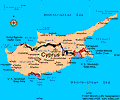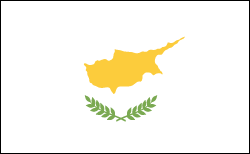Geography | Government | HistoryGeographyThe third-largest island in the Mediterranean (one and one-half times the size of Delaware), Cyprus lies off the southern coast of Turkey and the western shore of Syria. The highest peak is Mount Olympus at 6,406 ft (1,953 m). GovernmentRepublic. Mediation efforts by the UN seek to reunify the Greek and Turkish areas of the island under one federated system of government. HistoryCyprus was the site of early Phoenician and Greek colonies. For centuries its rule passed through many hands. It fell to the Turks in 1571, and a large Turkish colony settled on the island. In World War I, at the outbreak of hostilities with Turkey, Britain annexed the island. It was declared a Crown colony in 1925. The Greek population, which regarded Greece as its mother country, sought self-determination and union (enosis) with Greece. In 1955, a guerrilla war against British rule was launched by the National Organization of Cypriot Combatants (EOKA). In 1958, Greek Cypriot nationalist leader Archbishop Makarios began calling for Cypriot independence rather than union with Greece. During this period, Turkish Cypriots began demanding that the island be partitioned between the Greek and Turkish populations. Cyprus became an independent nation on Aug. 16, 1960, after Greek and Turkish Cypriots agreed on a constitution, which excluded both the possibility of partition as well as of union with Greece. Makarios became the country's first president. Fighting between Greek and Turkish Cypriots flared up in the early 1960s, and a UN peacekeeping force was sent to the island in 1965. On July 15, 1974, Archbishop Makarios was overthrown in a military coup led by the Cypriot National Guard. On July 20, Turkey invaded Cyprus, asserting its right to protect the Turkish Cypriot minority. Turkey gained control of 30% of northern Cyprus and displaced some 180,000 Greek Cypriots. A UN-sponsored cease-fire was established on July 22, and Turkish troops were permitted to remain in the north. In Dec. 1974, Makarios again assumed the presidency. The following year, the island was partitioned into Greek and Turkish territories separated by a UN-occupied buffer zone. Turkish Cypriots proclaimed a separate state under Rauf Denktash in the northern part of the island on Nov. 15, 1983, naming it the “Turkish Republic of Northern Cyprus.” The UN Security Council, in its Resolution 541 of Nov. 18, 1983, declared this action illegal and called for withdrawal. No country except Turkey has recognized this entity. In 1988, George Vassiliou, a conservative and critic of UN proposals to reunify Cyprus, became president. The purchase of missiles capable of reaching the Turkish coast evoked threats of retaliation from Turkey in 1997, and Cyprus's plans to deploy more missiles in Aug. 1999 again raised Turkey's ire. The continued strife between Greek Cypriots and Turkish Cypriots threatened Cyprus's potential EU membership—it had met all the economic standards—and provided a great incentive to both sides to resolve their differences. UN-sponsored talks between the Greek and Turkish leaders, Kleridas and Denktash, continued intensively in 2002, but without resolution. In Dec. 2002, the EU invited Cyprus to join in 2004, provided the UN plan was accepted by February 2003. Without reunification, only Greek Cyprus was to be welcomed into the EU. But just weeks before the UN deadline, President Kleridas was defeated by right-wing candidate Tassos Papadopoulos, a hard-liner on reunification. The UN deadline passed, and the UN declared that the talks had failed. In April 2004, dual referendums were held, with the Greek side overwhelmingly rejecting the most recent UN reunification plan, and the Turkish side voting in favor. In May, Greek Cyprus alone became a part of the EU. In April 2005, Turkish Cyprus elected pro-reunification leader Mehmet Ali Talat as their president, ousting longtime leader Rauf Denktash, who staunchly opposed reunification. In July 2006, the UN sponsored talks between President Papadopolous and Talat. In the second round of presidential elections in February 2008, Community Party leader Dimitris Christofias won 53.4% of the vote, defeating right-wing candidate Ioannis Kasoulidis, who took 46.6%. Christofias, who is Cyprus's first Commnunist president, vowed to work toward reunification and said he would meet with the Turkish Cypriot president, Talat. Papadopoulos was eliminated in the first round of voting. On March 21, 2008, President Christofias started talks of reunification with Turkish Cypriot president, Talat, as promised. On April 4, 2008, Ledra Street Crossing was torn down—an important symbolic step towards reunification. The checkpoint divided Greek and Turkish Cypriots in the capital city of Nicosia for decades. | ||||
Cyprus
Study the ancient and modern history of Cyprus, the third-largest Mediterranean island. Read this country profile to learn how Cyprus became an independent nation. This resource also includes information about the country's geography and government.
Subjects:
Infoplease
Provided by Infoplease—an authoritative, comprehensive reference website that offers an encyclopedia, a dictionary, an atlas, and several almanacs. Visit Infoplease.com to find more resources endorsed by teachers and librarians.








